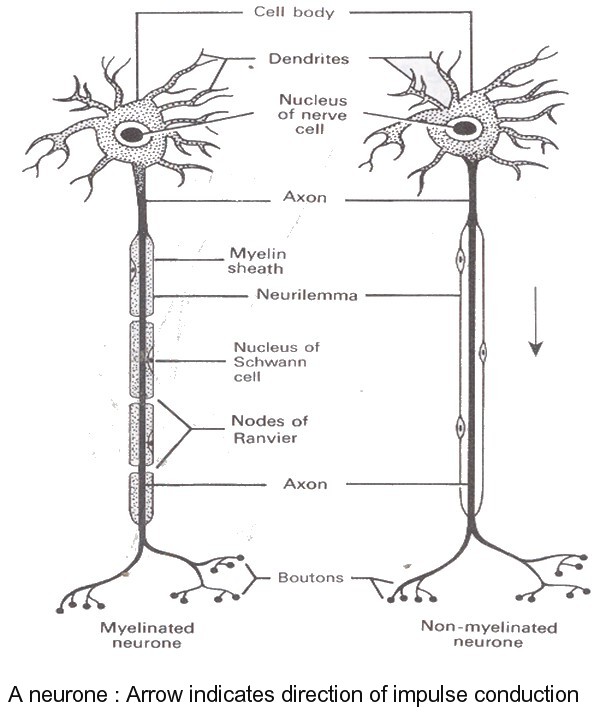Neurone
Definition
The basic unit of the nervous tissue
Structure
The nerve cell has
Body
Cytoplasm
Nucleus - contains genetic material (chromosomes). Covered by a membrane.
Chromosomes
Nucleolus - produces ribosomes
Extension of the cell body called dendrites - which receive chemical messages from other neurones
Endoplasmic reticulum - system of tubes for transport of materials within cytoplasm.
Golgi Apparatus - membrane-bound structure important in packaging peptides and proteins (including neurotransmitters) into vesicles.
Microfilaments/Neurotubules - system of transport for materials within a neuron and may be used for structural support.
Mitochondria - produce energy to fuel cellular activities.
The axon - an extension different from other extensions - transmits electro-chemical signals to other neurones
Longer axons have myelin sheaths - insulation
At the end of axon - there is the synaptic knob (Bouton) - at the knob electro-chemical signal is converted into chemical message.
Neurons are surrounded by a cell membrane.
Types of Neurons
1. Sensory neurons : in the skin, muscles, joints, and organs that indicate pressure, temperature, and pain.
2. Motor neurons : stimulate muscle cells
3. Interneurons : provide connections between sensory and motor neurons, as well as between themselves.
An interneuron (also called relay neuron, connector neuron, intermediate neuron) create neural circuits, enabling communication between sensory or motor neurons and the central nervous system (CNS). They function in reflexes, neuronal oscillations.
Nomenclature
A clump of neuron cell bodies is called a ganglion (plural: ganglia) or a nucleus (plural: nuclei).
A fiber made up of many axons is called a nerve.
In the brain and spinal cord, areas that are mostly axons are called white matter
Areas that include large number of cell bodies are called gray matter.
Saltatory Conduction of Nerve impulse
Saltatory conduction ( hop or leap) is the propagation of action potentials along myelinated axons from one node of Ranvier to the next node, increasing the conduction velocity of action potentials.





